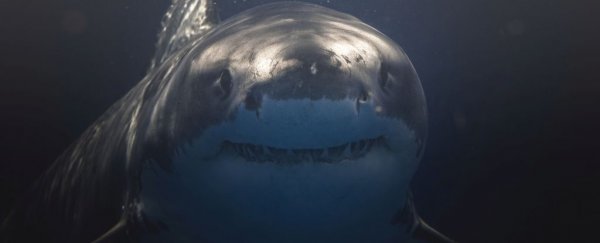Megalodon. The very name conjures awe: A giant shark that once dominated the world's oceans, big enough to swallow a human whole. Such a beast – known only from teeth and vertebrae that survived the 3.6 million years since it went extinct – must have been fearsome indeed.
It was one of the largest carnivores ever to have lived… and yet, there is one predator still living today whose very existence may have brought the mighty megalodon (Otodus megalodon) to its fins: the great white shark (Carcharodon carcharias).
Recent research found that the two animals lived contemporaneously, suggesting that the great white shark may have played a significant role in the megalodon's decline simply by occupying the same ecological niche – living in the same habitats, and hunting the same food.
Now a new study, using a different metric – the isotope ratios of zinc in the animals' teeth – has come to the same finding. This constitutes more evidence that great whites were instrumental in sending the megalodon to a watery grave.
"We reveal that dietary zinc signatures are preserved in fossil shark tooth enameloid over deep geologic time and are robust recorders of each species' trophic level. We observe significant zinc differences among the Otodus and Carcharodon populations implying dietary shifts throughout the Neogene in both genera," wrote a team led by geoscientist Jeremy McCormack of the Max Planck Institute for Evolutionary Anthropology in Germany.
"Notably, Early Pliocene sympatric C. carcharias and O. megalodon appear to have occupied a similar mean trophic level, a finding that may hold clues to the extinction of the gigantic Neogene megatooth shark."
How ancient people and animals ate isn't as difficult to figure out as you might think, especially if teeth have been preserved. And with sharks, whose cartilaginous skeletons are not preserved in the fossil record, teeth are pretty much all we have.
Here's how it works. Combinations of isotopes in any given environment are taken up by organisms in that environment. When something with teeth comes along and eats those organisms, they also absorb the isotopes. Some of those isotopes replace some of the calcium phosphate in the muncher's teeth and bones, which scientists can use to better understand their diet.
Now, in the case of megalodons and great whites, we don't know exactly what they ate. But studies of the ratios of isotopes of zinc in ancient, paleontological marine mammal bones suggest that the higher the trophic level of an organism – that's the position it occupies in the food web – the lower the values of the zinc isotope ratios.
However, very little analysis had been done on non-mammalian marine vertebrates, and this is the niche McCormack and his team sought to address.
They created a database of zinc isotope ratios found in the teeth of 20 living shark species, including some living in aquaria. They also obtained isotope ratios from 13 extinct species, including megalodon. This information allowed them to determine the trophic level of each species.
Next, they compared the teeth of megalodon against the teeth of great white sharks, and this is where it gets pretty interesting.
During the early Pliocene, an epoch that lasted between 5.33 million and 2.58 million years ago, the two species coexisted, but not easily. Their zinc isotope ratios suggest that they occupied the same trophic level, competing for resources.
Megalodon, which lived from 23 million years ago, died out around 3.6 million years ago, in the middle of the Pliocene. It's unlikely that great white sharks, getting all up in megalodons' predator business, were the only cause of their decline, but it's looking pretty possible that the smaller species played a not-insignificant role.
"The extinction of Otodus megalodon could have been caused by multiple, compounding environmental and ecological factors, including climate change and thermal limitations, the collapse of prey populations and resource competition with Carcharodon carcharias and possibly other taxa not examined here," the researchers wrote.
"In general, our study demonstrates [zinc isotope ratios] to be a powerful, promising tool to investigate the trophic ecology, diet, evolution, and extinction of fossil marine vertebrates."
Future analysis of the giant teeth of these mysterious ancient sharks may shed more light on the way they lived and died, long ago.
Meanwhile, if you're feeling worried about a shark so voracious that it could help eradicate even megalodon, go make friends with an orca.
The research has been published in Nature Communications.
